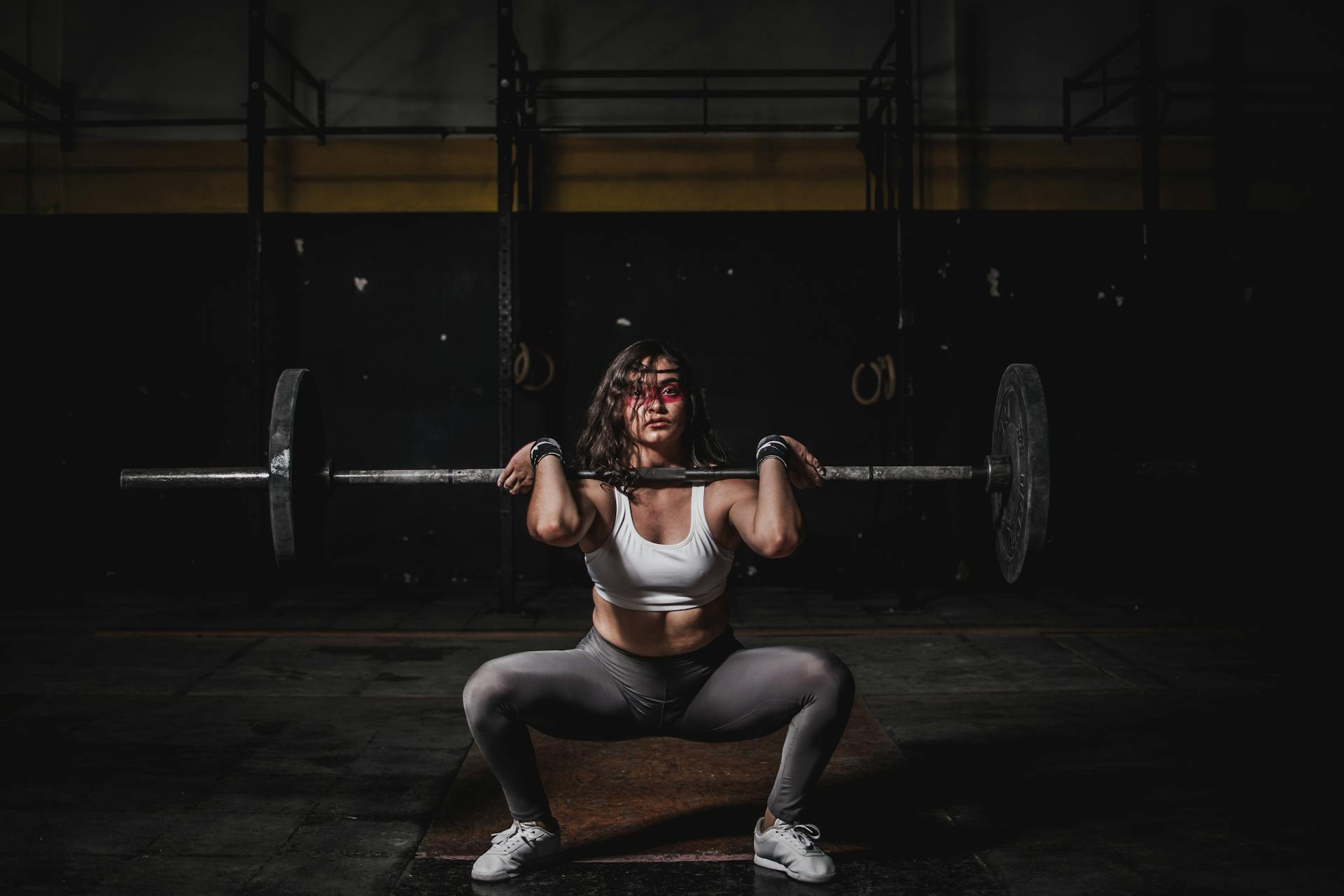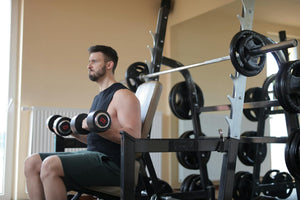
How to Use a Lifting Belt: Tips, Tricks, and How to Get Started
Are you just starting to use a weightlifting belt?
If so, you might not be sure about the best way to make the most of it during your workouts.
Properly using a lifting belt can significantly enhance your training by providing the necessary support to tackle heavier lifts, ensure your safety during your workout, and boost your confidence. On the contrary, failing to put on your belt the right way can lead to injury.
Understanding the ins and outs of how to use a lifting belt can be a game-changer that unlocks the next level of your gym performance and progress.
So, with that in mind, let’s take a deeper dive into our guide to using a lifting belt!
What Is a Lifting Belt?
A weightlifting belt is a piece of equipment that supports your lower back and core during heavy lifting. You wear the belt around your waist, where it fits snugly over your abdominal area and lower back to stabilize your midsection and prevent too much stress on your spine.
When lifting heavy weights, your core muscles protect your spine. Adding a lifting belt to your routine provides extra support and allows you to lift even more weight. A weightlifting belt increases intra-abdominal pressure, supporting the spine from the inside and reducing the risk of back injuries, all while boosting your lifting performance.
However, a lifting belt isn't a magic solution for lifting more weight without learning the proper technique. A belt works best for weightlifters who already have good form and want to take their lifting to the next level.
How to Use a Lifting Belt
Using a weightlifting belt can be a game-changer for your strength training routine.
The belt can provide support for heavier weights and enhance your overall performance.
But you can only reap these benefits if you know how to use your lifting belt correctly. Misusing your belt can lead to ineffective support or even a serious injury.
The goal of a weightlifting belt is to increase intra-abdominal pressure and create a solid and stable core. The pressure supports your spine during heavy lifts and helps prevent injuries.
That said, there is a right and wrong way to wear a lifting belt. You can’t just strap it on and automatically improve - it’s a piece of gym equipment that requires proper positioning, breathing, and bracing techniques to get the most out of it.
Let’s go through the step-by-step process of how to use a lifting belt:
#1. Find Your Hip Bone
When it’s time to put on your weightlifting belt, start by finding your hip bone.
Position the belt just above the hip bone for optimal support. This way, it won’t dig into your hips or ribs when you bend or lift.
It's all about finding a comfortable spot where the belt can sit tightly without causing major discomfort or hindering your movement.
#2. Breathe In
Take in a deep breath before tightening your belt.
The goal here is to expand your abdomen, so you can set the belt at the correct tightness.
You want to create enough space for your stomach to expand against the belt, which in turn increases the intra-abdominal pressure that stabilizes your core during lifts.
Getting a weightlifting belt isn’t enough. Check our tips on how to properly take care of it to ensure your belt lasts for a long time.
#3. Latch It On
Next, it’s time to fasten the belt.
Make sure it's snug but allows you to breathe and move with ease.
A good test is sliding a few fingers between the belt and your body. This means it's tight enough to support you without cutting off your breathing or limiting your mobility.
#4. Breathe Out and Brace
Once the belt is securely latched, breathe out and then brace your core against the belt.
Bracing is what creates the necessary intra-abdominal pressure to support your spine.
To give you an example, imagine you're about to be punched in the stomach. You want to create tension in your muscles to absorb the punch and it works like that with a weightlifting belt, too.
This tension, combined with the support of the belt, is what’s going to provide a solid foundation for your lift.
#5. Check the Fit
Before you start lifting, check how the belt fits.
Your weightlifting belt should be snug and secure, but not so tight that it causes pain or significantly restricts your movement.
You should be able to perform your lifts with the belt providing a firm, supportive pressure on your abdomen. If the belt shifts or feels too loose or too tight, adjust it as needed before proceeding with your lifts.
Should You Use a Lifting Belt?
Whether you should start using a lifting belt or not depends on your training goals and experience.
Lifting belts can boost your safety by supporting your lower back and stabilizing your core during heavy lifts. Extra support can be crucial for avoiding injuries when lifting around your one rep max.
A weightlifting belt can also help you lift more weight than usual.
The belt creates a higher level of intra-abdominal pressure, which stabilizes your spine and lets you apply more force during lifts. So, using a belt regularly can lead to a significant strength gain over time, since you can train more effectively with heavier weights.
But weightlifting belts aren’t necessary for everyone. Beginners, in particular, should focus on developing proper form and core strength before relying on a belt. Using a lifting belt too early in your training can lead to over-reliance on it and potentially neglect the natural development of core stability.
Types of Lifting Belts
Weightlifting belts come in different designs, and each offers distinct advantages and drawbacks.
The belt's material, width, and closure type all influence how it performs and how effective it is for different lifts.
Knowing what makes these belts work is the key to choosing the right belt, whether your focus is on intense lifting or combining strength and conditioning workouts.
Let's dive into the details of each belt type:
Lever
This type of weightlifting belt uses a lever system to fasten the belt. It's easy to put on and offers a tight and secure fit once you adjust it.
However, lever belts are harder to tighten or loosen. With that in mind, a lever belt might not be an ideal choice for people whose weight fluctuates.
Prong
Prong weightlifting belts are popular among athletes, especially because they are flexible and easy to adjust. Their adjustability is especially beneficial for those who often change weight or clothing, ensuring lifters can always secure the belt to their liking for optimal support and performance during various exercises.
Although adjustable, prong belts do not provide as tight fit as other types. In turn, that could increase the risk of injury during heavy lifts, as this belt doesn't always offer adequate support.
Velcro
Velcro belts are ideal for activities requiring high mobility, such as CrossFit. These belts are known for their comfortable fit, which can be a significant advantage during workouts that involve a lot of movement, twists, and turns.
However, velcro belts do have some drawbacks. Over time, they can lose their stickiness, leading to a weaker grip that may not hold as securely during exercises. This weakening can affect the belt's ability to provide consistent support during workouts.
Still not sure which type of weightlifting belt is the best for you? Take a look at our detailed guide and find out!
Who Should Use a Lifting Belt?
Whether you need a lifting belt depends on your experience, what kind of lifting you do, and your weightlifting goals. A lifting belt might not fit your training style, so it’s important to know when and how using a belt works best.
Here are the specific types of lifters who can benefit most from using a lifting belt:
#1. Strongman Athletes
Strongman athletes tackle a variety of challenges that demand exceptional strength and endurance. Utilizing a lifting belt provides these competitors with crucial lower back support and core stabilization during heavy lift events such as atlas stones, tire flips, and log presses.
A lifting belt offers vital support for maintaining proper form and minimizing the risk of injury when lifting irregularly shaped and extremely heavy objects, so these athletes should always invest in a quality belt.
The belt's ability to increase intra-abdominal pressure is a great asset during sports or exercises that require a combination of lifting and carrying, and it helps athletes perform at their peak while protecting their spine.
Wearing a weightlifting belt can also provide a psychological boost that encourages athletes to push their limits. The feeling of support and security that comes with wearing a lifting belt can help any strongman excel in their craft.
#2. Powerlifters
Every pound added to a lift counts towards the total score in powerlifting, so a lifting belt can be an invaluable asset.
The belt helps support a powerlifter’s lower back and boosts their core's stability which is especially important for squats and deadlifts.
Additionally, powerlifters can use the belt as a tool to refine their technique. The support provided by the belt helps lifters maintain an upright position and proper form when under the stress of maximal loads.
Using a lifting belt reinforces safe lifting practices and reduces the likelihood of long-term injuries. As powerlifters progress and lift increasingly heavier weights, the belt becomes a critical piece of equipment for sustaining growth and ensuring the lifter's safety and success in the sport.
Make sure you understand the difference between weightlifting and powerlifting belts before buying one!
#3. Olympic Weightlifters
Olympic weightlifting requires a unique blend of power, speed, and technique – they all make the lifting belt a strategic addition to an athlete's gear.
Weightlifting belts support the explosive movements involved in exercises like the snatch, which provides a solid base for generating force.
The spine stabilization the belt offers can be particularly beneficial during the catch phase of these lifts, where the athlete receives the barbell in a deep squat position. This support helps in maintaining a strong, stable core that’s for the successful completion of the lift and for minimizing the risk of injury.
However, Olympic weightlifter should choose their belts wisely, since they need a belt that can offer support without compromising mobility.
Do you want to level up your workouts? Find out when is the right time to start using assistive equipment!
#4. Recreational Fitness Goers
Recreational fitness enthusiasts who include weightlifting in their routines can benefit from the added support and safety a lifting belt provides, especially when venturing into heavier weights.
A weightlifting belt can help maintain proper form and reduce the risk of lower back injuries, which are common when pushing past personal limits. A weightlifting belt is a tool that can make challenging lifts more accessible and safer, as well as allow fitness goers to confidently explore their strength potential.
That being said, recreational lifters need to remember that the belt is an aid, not a crutch. Working on core strength and lifting technique is the foundation of their training, and neglecting it because the belt gives them a sense of security is a huge mistake.
For casual lifters, a weightlifting belt can also serve as a reminder to engage their core and maintain proper posture during lifts and when increasing their lifting intensity. Recreational lifters may not have the same level of coaching or guidance, so the belt can provide additional support and feedback.
When to Start Using a Lifting Belt?
Deciding when to start using a weightlifting belt is a personal journey that varies from one person to the next.
Beginners might not need a belt right away, as it's essential to first focus on mastering form and building core strength. More seasoned athletes, however, may find a belt beneficial for supporting their performance as they tackle heavier weights.
Certain “athletic achievements” can indicate that you can start using a lifting belt in your workout routine.
For example, if you reach the point where you can squat your body weight or deadlift one and a half times your body weight, it may be an appropriate time to think about using a belt. Hitting these milestones suggests you're lifting weights heavy enough to benefit from the additional support and protection a belt offers.
There are also specific exercises that require using a belt, especially because of the additional support and safety. These exercises typically involve significant loads that can put stress on the lower back, including:
- Squats
- Deadlifts
- Overhead presses
- Cleans and snatches
Integrating a belt into these exercises can help stabilize your core, enhance your lifting technique, and potentially prevent injuries. However, you should listen to your body and consult a coach to determine the best time to start using a belt in your training routine.
How Tight Should a Lifting Belt Be?
The tightness of a lifting belt determines how effective it is.
The lifting belt should be tight enough to provide support for your core and back, without restricting your breathing or movement. It should feel like a firm hug around your waist that offers resistance without causing too much discomfort.
A good rule of thumb is that you should be able to fit one or two fingers between the belt and your body. This space ensures that the belt is snug but also allows for the expansion of your abdomen when you inhale deeply before a lift.
Adjust the tightness of your lifting belt based on the type of lift you're performing. For exercises that require more mobility, such as deadlifts, you might need a slightly looser fit, while other exercises like squats need less flexibility and tighter support.
First and foremost, always listen to your body. If the belt is causing you pain or significantly hindering your movement, it's too tight. Adjust the tightness as necessary when you switch between different lifts so you can maximize the belt's benefits while ensuring your safety and comfort.
Frequently Asked Questions
Do you still have some questions on how to use a lifting belt? Let’s check out the answers to some of the most popular questions on the topic:
#1. Is It Safe to Use a Lifting Belt?
Yes, it's safe to use a lifting belt if you do it correctly.
A lifting belt supports your lower back and increases core stability during heavy lifting which reduces your risk of injury.
However, you should only use the belt with proper lifting techniques and never rely on it as a substitute for core strength.
#2. What Kind of Weightlifting Belt Should I Get?
The kind of weightlifting belt you should get depends on your lifting style and personal preference.
A thick, sturdy leather belt with a prong or lever closure is ideal for heavy lifting.
On the other hand, a lighter, more flexible nylon belt with a Velcro closure might be more comfortable for general strength training and bodybuilding.
#3. Is Wearing a Weightlifting Belt “Cheating”?
Wearing a weightlifting belt is not "cheating."
A weightlifting belt is a tool that helps increase intra-abdominal pressure and stabilize your core during heavy lifts. It can enhance your performance and safety but it can never substitute skill.
Weightlifting requires proper form and technique which a lifting belt can complement but never replace.
#4. Does Wearing a Weightlifting Belt Make You Weak?
Wearing a weightlifting belt will not make you weak.
Instead, a lifting belt can help you train harder and safer by supporting your spine and encouraging proper form. Over time, this can help you increase the weight of your lifts.
During your training, it’s also crucial to focus on building core strength to avoid overreliance on the belt, so there’s no way for the belt to weaken you.
#5. Does a Lifting Belt Automatically Protect Your Back?
A lifting belt does not automatically protect your back.
While a belt can significantly reduce the risk of injury by providing support and allowing you to maintain better form, it’s only effective if you use it correctly.
Learn the proper lifting techniques and focus on building core strength. Relying solely on the belt and ignoring all other aspects of weight training can lead to serious injuries.
Conclusion
Incorporating a lifting belt into your training can be a game-changer that provides the support and stability you need for heavier lifts and better performance. A weightlifting belt is a tool you can use to enhance your training but it’s not a quick fix.
If you're ready to take your lifts to the next level, consider investing in a quality lifting belt today. We offer premium weightlifting belts that let you choose the right one for your needs and level of experience.
Get started with yours and feel the support that can help you achieve your strength goals safely and effectively!





![How Tight Should a Weightlifting Belt Be? [Full Guide & Tips!] - Gunsmith Fitness](http://gunsmithfitness.com/cdn/shop/articles/how-tight-should-a-weightlifting-belt-be-full-guide-tips-491867_380x200.jpg?v=1710322916)
